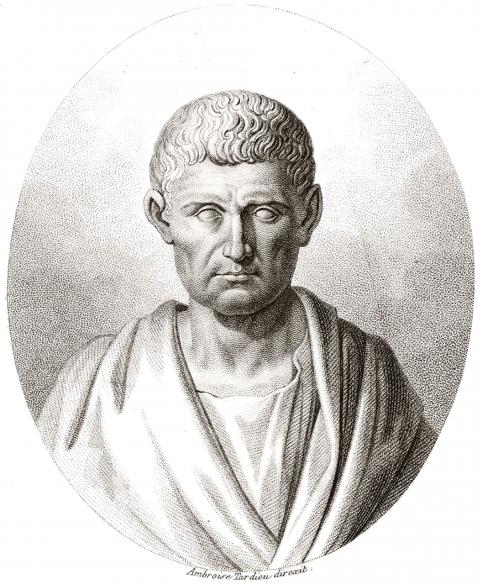Chinese practice
多才多藝
many talents, many arts

Photo: Wikimedia Commons
照片:維基共享資源
(duo1 cai2 duo1 yi4)
根據中國古代史書《尚書》〈金滕〉記載,約在西元前一○四四年,也就是周朝滅商後兩年,周武王生了重病。武王的弟弟周公便舉行問卜儀式,向諸先王請示周武王是否能夠康復,周公甚至祈求,若必須有人犧牲,他願意獻上自己的生命來代替周武王死。周公在問卜中向祖先說:「我對尊長柔順,且我多才多藝,所以我很適合為鬼神服務。」周公繼續向祖先說,「你們的長孫(即周武王)不如我有才能,不適合為鬼神服務,因此還是留在世上做人世間的王比較好,而非到天上服事祖先神靈」。在《尚書》的這段記載中,描述擁有多樣的才能是寫做「多材多藝」。
這句話在一九○九年吳趼人所著之小說《二十目睹之怪現狀》則稍有不同。書中主人公看見一個玉製如意,是一位精通琴棋書畫的友人蔡侶笙所製贈,其上還刻有文章,字體細小卻筆畫分明,極為精美,便驚嘆道:「那字刻得細入毫芒,卻又波磔分明,蔡侶笙真是多才多藝!」在此處,吳趼人使用了「多才多藝」一詞來形容博學之人。
英語「polymath」(博學家)一字可追溯至十七世紀初。它是由希臘語的「許多」(polu-)和「學習」(manthanein)而來,意指深刻掌握多種學門領域的人,近似所謂「文藝復興人」的理想;其義與形容人博而不精、樣樣通,樣樣鬆的「jack of all trades」相反。
隨著今日所需之學門分科愈趨專業化,真正的博學家已越來越少見。歷史上著名的博學家包括古希臘的亞里斯多(西元前三八四~三二二年),他在物理學、形而上學、詩歌、戲劇、音樂、邏輯、修辭、政治學、倫理學、生物學,及動物學等領域成就斐然。伊拉克的海什木(西元九六五~一○三九年)是科學家、物理學家、解剖學家、內科醫生、心理學家、天文學家、工程師、發明家、數學家、眼科醫生、哲學家,及神學家。中國的沈括(西元一○三一~一○九五年)是科學家、政治家、數學家、天文學家、氣象學家、地質學家、動物學家、植物學家、藥理學家、農學家、百科全書作者、詩人、將軍、外交家、水利工程師,及發明家。達文西(西元一四五二~一五一九年)是義大利文藝復興時期的畫家、發明家、工程師、天文學家、解剖學家、生物學家、地質學家、物理學家,以及建築師。
(台北時報編譯林俐凱譯)
英文練習
Polymath; Renaissance man
According to the Metal-bound Coffer chapter of the ancient Chinese historical classic the Shangshu (Book of Documents), in around 1044 BCE, two years after the conquest of the Shang, King Wu of the conquering Zhou fell seriously ill. The Duke of Zhou, the king’s younger brother, performed a divination to ask the king’s deceased ancestors what his chances of survival were, and offered himself in place of the king, should anyone have to die. “I was lovingly obedient to my father,” he said; “I am possessed of many abilities and arts, which fit me to serve spiritual beings.” The king, said the duke, was not so endowed, and would therefore be better employed serving the kingdom on Earth, rather than the ancestor spirits in Heaven. In the text, the phrase “possessed of many abilities and arts” is written 多材多藝.
That phrase, albeit in slightly different form, was used in the 1909 novel Bizarre Happenings Seen Over Two Decades by Wu Jianren. In the book, the protagonist comment on a jade ruyi scepter made by Cai Lusheng, a man skilled in zither, chess, painting and calligraphy, with an inscription on the back meticulously carved in tiny Chinese characters by Cai himself. He exclaimed, “how fine and delicate the writing, and yet so distinct each character: this person is truly a polymath.” To express “polymath,” Wu used the phrase 多才多藝.
The word “polymath” dates back to the early 17th century. It is derived from the Greek for “many” (polu-) and “learn” (manthanein). It means someone with a profound mastery of diverse disciplines, as opposed to “jack of all trades,” which implies mere competency in several fields, and is close to the “Renaissance man” ideal.
With the more intense specialization in branches of study demanded today, true polymaths are increasingly rare. Past examples include Aristotle (384–322 BC), who excelled in physics, metaphysics, poetry, theater, music, logic, rhetoric, politics, ethics, biology and zoology; Ibn al-Haytham (965–1039), an Iraqi scientist, physicist, anatomist, physician, psychologist, astronomer, engineer, inventor, mathematician, ophthalmologist, philosopher and theologian; Shen Kuo (1031–1095), a Chinese scientist, statesman, mathematician, astronomer, meteorologist, geologist, zoologist, botanist, pharmacologist, agronomist, encyclopedist, poet, general, diplomat, hydraulic engineer and inventor; and Leonardo da Vinci (1452–1519), the Italian Renaissance painter, inventor, engineer, astronomer, anatomist, biologist, geologist, physicist and architect.
(Paul Cooper, Taipei Times)

As the priest Antonius Hambroek stood in the dim chamber of Fort Zeelandia, his eldest daughter clung to him, her voice trembling. “Father, don’t go. They’ll kill you, and what will become of Mother and my sisters?” Outside, the sounds of Koxinga’s relentless canon siege boomed through the fortress. The defenders were on the brink of collapse. Starvation gnawed at their resolve, and the air carried the acrid stench of spent gunpowder and rotting flesh. Dutch reinforcements from Batavia had failed to arrive, leaving the garrison isolated and hopeless. Hambroek’s face was calm, though sorrow weighed heavily on his

As we bundle up in thick coats to stay warm during the winter, there is a population that has already adapted to extremely low temperatures. These people live in the remote city of Yakutsk, the coldest city on Earth. Yakutsk is situated in the heart of Siberia, which is the capital of the Sakha Republic in Russia. This historic mining city began to flourish in the 19th century following the discovery of gold deposits. Given its construction on permafrost, the average temperature in the city remains below 0°C for over half the year, with winter temperatures dropping to an astonishing -50°C.

The Dutch introduced the Indian mango (Mangifera indica) to Taiwan in the 17th century. It is a green-skinned mango with thick fibers that get stuck in the teeth, but it boasts a rich aroma and a unique taste. In 1954, Taiwan’s Council of Agriculture introduced several mango cultivars from Florida, USA, including the Irwin, Haden, and Keitt varieties. After seven years of testing and domestication, the Irwin variety was chosen for promotion. Years later, the sample saplings started to bear fruit. These mangoes were large, with thin, vibrant red peels and golden pulp. The Irwin mangoes were mouth-wateringly sweet and

A: Happy Year of the Snake! Did you do anything special during the Lunar New Year holiday? B: I went to K-pop girl group Apink’s concert. How about you? A: I just stayed at home. But I’m going to girl group 2NE1’s show on Saturday. B: Wow, I really love their megahit “I Am the Best,” better known by its Korean title “Naega jeil jal naga.” A: I’m so glad that 2NE1 reunited last year, eight years after they disbanded in 2016. A: 蛇年快樂!你春節有做什麼特別活動嗎? B: 我去了南韓女團Apink的演唱會,你呢? A: 我都宅在家裡,不過這週六要去韓流天團2NE1的演唱會。 B: 我愛該團神曲《我最紅》,韓文歌名《Naega jeil jal naga》超洗腦。 A: 她們2016年解散8年後,去年終於合體真令人開心。 (By Eddy Chang, Taipei